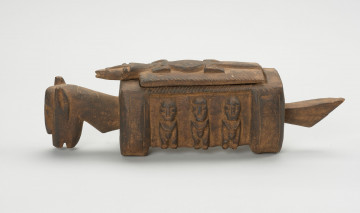
Door lock with key
między 1951 — 1996
National Museum in Szczecin
Part of the collection: Collection of Dogonian art
The Dogon are typically agricultural people who cultivate several species of cereals by fennel crop. They are characterised by a complex social structure and a rich spiritual culture. They are divided into four great primary groups, which derive from one of four mythical ancestors: Dyon, Domno, Arou and Ono. These groups, in turn, are divided into 80 families. Apart from these, among the Dogon, several families are considered separate castes, distinguished by cultural distinctiveness and a different status. The existence of four castes has been noted: the gogon griots (those engaged in memorising and passing on local traditions, recited to the accompaniment of a musical instrument), blacksmiths, leatherworkers and weavers. The different castes are defined according to the occupation performed by men. Still, these groups also include women who specialise in other fields, e.g. women from the smiths' caste are potters, while the wives of the leather workers deal with dyeing cotton cloth with indigo. People belonging to castes have a lower position than farmers; they are not circumcised, do not cultivate the land (skinners are an exception), cannot occupy certain positions, participate in festivals and rituals, and marry only within their own caste.The inhabitants of the Bandiagara Escarpment have fascinated both scholars and travellers for years. Prominent researchers interested in their culture include Marcel Griaule, Germaine Dieterlen, Solange de Ganay, Denise Paulme. Polish anthropologists Ryszard Vorbrich, Jacek Łapott and Lucjan Buchalik, who for over forty years have been visiting Dogon villages learning about their culture, should not be overlooked either.
Ewa Prądzyńska
Author / creator
Dimensions
cały obiekt: height: 24,4 cm, width: 21,2 cm
Object type
door
Creation time / dating
Creation / finding place
Identification number
Location / status

między 1951 — 1996
National Museum in Szczecin
około 1970
National Museum in Szczecin

między 1951 — 2000
National Museum in Szczecin
DISCOVER this TOPIC
National Museum in Szczecin
DISCOVER this PATH
Educational path